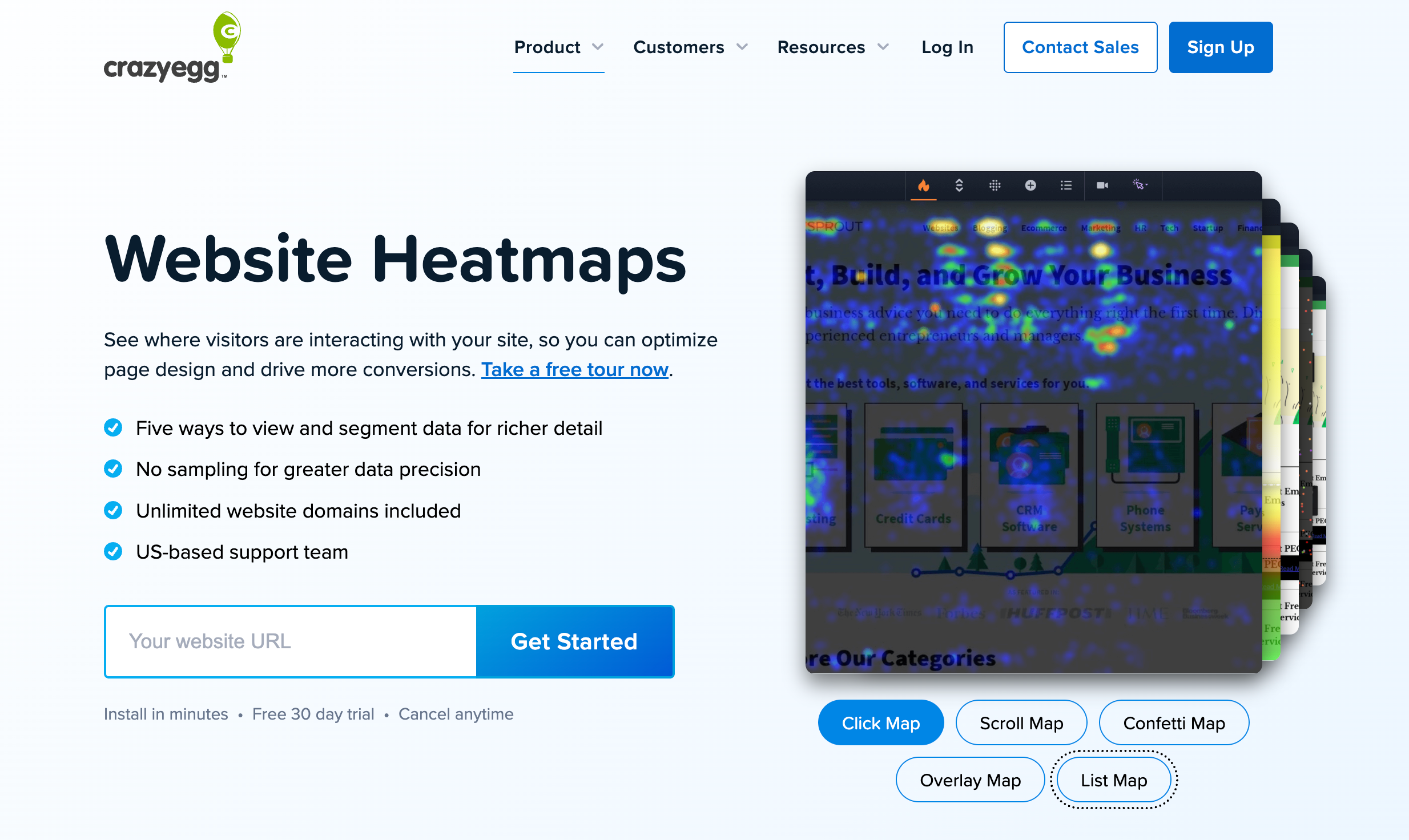Microsoft Clarity and Hotjar both offer heatmaps, session recordings, and analytics to help you understand how people interact with your website.
Microsoft Clarity is better if you’re on a budget and need basic insights to grow. Hotjar is ideal if you want more in-depth insights, user surveys, and a wider pool of integrations.
Let’s take a closer look at how these two website analytics tools stack up—and which one is right for you.
Microsoft Clarity vs. Hotjar: A Quick Snapshot
TL;DR? Here’s a quick overview of Microsoft Clarity and Hotjar.
| Feature / Focus Area | Microsoft Clarity | Hotjar |
| Best for | Marketers, SMBs, and teams wanting free, unlimited session tracking | UX pros needing in-depth insights, surveys, and collaboration tools |
| Learning curve | Low—very beginner-friendly, minimal setup required | Moderate – more options and setup steps |
| Setup time | Fast-paste script or use integrations | Slower – more configuration and customization |
| Heatmaps | ✅ Click, scroll, area maps, rage clicks | ✅ Click, scroll, movement, engagement, and rage maps |
| Session Recordings | ✅ Unlimited, easy-to-use; basic segmentation with 40+ filters | ✅ Advanced filtering by traffic source, device, behavior, and integrations |
| Surveys & Feedback | ❌ Not included | ✅ Surveys, on-page widgets, interview scheduling |
| A/B Testing | ⚠️ Not included natively, but available through integrations. | ⚠️ Not included natively, but available through integrations. |
| Real-time activity | ⚠️Can view live recordings, but not live metrics | ❌ Not available |
| Dashboards & Funnels | ❌ Not available natively | ✅ Built-in dashboards and multi-step funnel tracking |
| Privacy & Compliance | ❌ Limited controls; Microsoft can use data for AI & marketing | ✅ Privacy-first; GDPR & CCPA compliant |
| Overall vibe | Free, simple, unlimited tracking with fewer features | More powerful insights with surveys & funnels, but higher learning curve and cost |
Feature Breakdown: Microsoft Clarity vs. Hotjar
Here’s a more in-depth features breakdown for each of these website analytics tools. We’ll outline how well each tool stacks up, feature by feature.
Heatmaps
Microsoft Clarity
Clarity offers multiple types of heatmaps, including:
- Click. See where web visitors click the most on each page.
- Scroll. Analyze how far down your visitors scrolled.
- Area. Add up how many clicks a specific area got.
- Attention. See where on the page your visitors spend the most time.
- Conversion (for Shopify users). Find out which elements (CTA buttons, links, and so forth) are driving conversions.
In addition, Microsoft Clarity partners with Microsoft Copilot to generate written summaries of your heatmaps so they’re easier to digest and understand. You can also compare heatmaps from different date ranges to analyze any changes in user behavior.
Setup is fairly easy and just takes a few clicks. Clarity integrates with Squarespace, Shopify, WordPress, Weebly, and Wix, among others. Or, you manually set up tracking using the provided code.
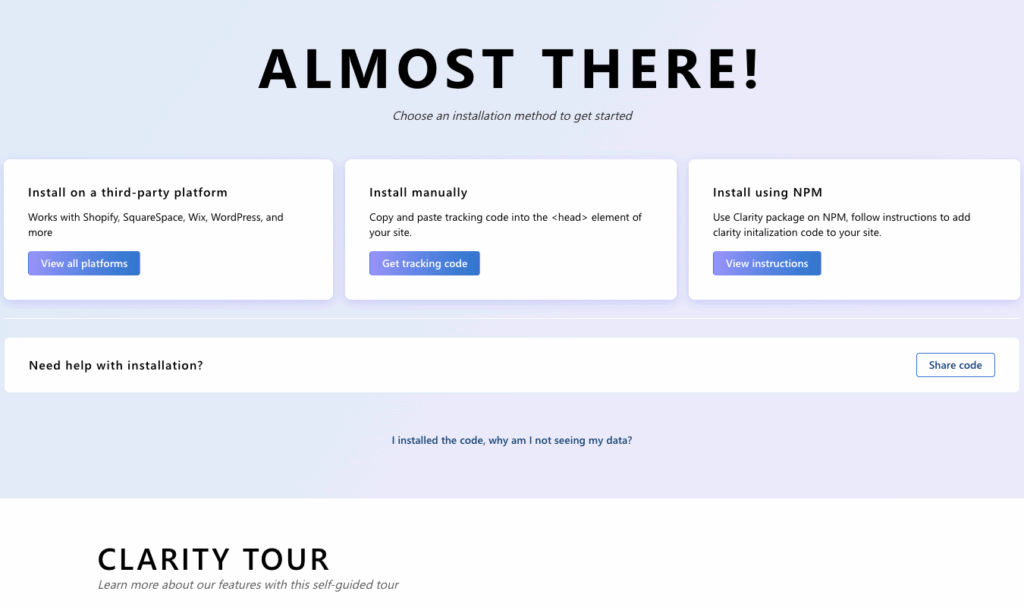
Hotjar
Like Clarity, Hotjar also offers a range of heatmaps, including click and scroll. But it also offers three advanced heatmap types:
- Rage heatmap. Shows where users repeatedly click or tap out of frustration. (Because even though we all know rage clicking is futile, we’ve all done it. And Hotjar can measure it!)
- Move heatmap. Tracks where users move their mouse, which helps show where they’re focusing their attention, even if they don’t do any clicking.
- Engagement heatmap. Combines click, scroll, and move data to show you the sections that get the most interactions.
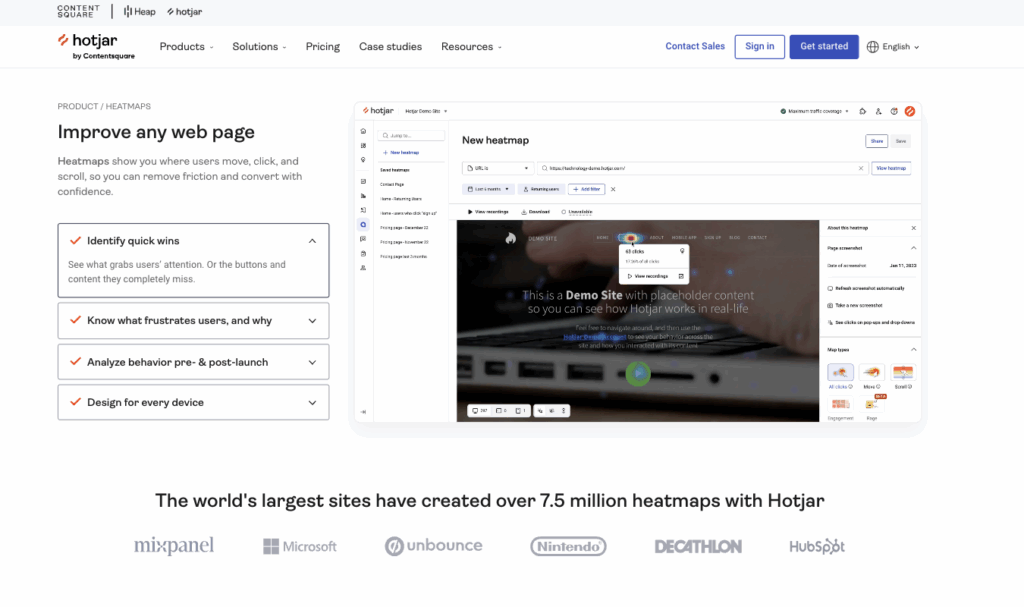
Hotjar also allows users to take the data from heatmaps and use other tools—like recordings, surveys, feedback, and analytics—to understand and interact with it. In this way, Hotjar offers a more integrated, holistic flavor of heatmaps than Microsoft Clarity does.
Session Recordings
Microsoft Clarity
For session recordings, Microsoft clarity offers the full gamut of features, including:
- Filters. Sort recordings by rage clicks, session length, number of pages visited, and other criteria.
- Labels. Tag recordings and organize them into categories for future reference.
- Favorites. Mark which recordings are most important and access them easily.
- AI-powered summaries (with Microsoft Copilot). Need help analyzing what you’re seeing? Copilot can summarize it for you.
- In-session heatmaps. View heatmaps for any page from within the recording so you can instantly see which areas received the most clicks, scrolls, or taps during that exact user session. All without leaving the replay view.
- Detailed events tab. Easily navigate between different moments in a recording by viewing the events tab, which breaks down every action and ties it to a timestamp.
- Skip the boring stuff. No, really. Clarity lets you skip through the moments when there’s no activity so you’re not stuck waiting minutes or hours for the next user action.
- Live recordings. See what users are doing in real-time on your site.

Microsoft retains recordings for 30 days unless you tag or favorite them to be saved for 13 months.
Hotjar
Hotjar offers advanced screen recording capabilities that line up pretty tidily with those of Microsoft Clarity:
- Advanced filters. Zero in on sessions by traffic source, clicked elements, device type, country, events triggered, or funnel stage.
- Highlights. Clip specific moments from a recording and save them to collections for team review or future reference.
- Notes and comments. Leave feedback directly on a recording for your team for easy collaboration with others—or with your future self. (I can’t be the only one who leaves “notes to self” all over my work!)
- Behavior tagging. Automatically tag sessions with signals like rage clicks, u-turns, or excessive scrolling so you can easily discover it again later.
- In-session context. Jump from any moment in a playback to related heatmaps, feedback responses, or funnel data for that user’s journey.
- Event timeline. Scan the full sequence of user actions in a visual timeline. This way, you can easily jump to critical points without rewatching every second.
- Skip inactivity. Automatically bypass idle periods so you only watch the meaningful parts of a session.
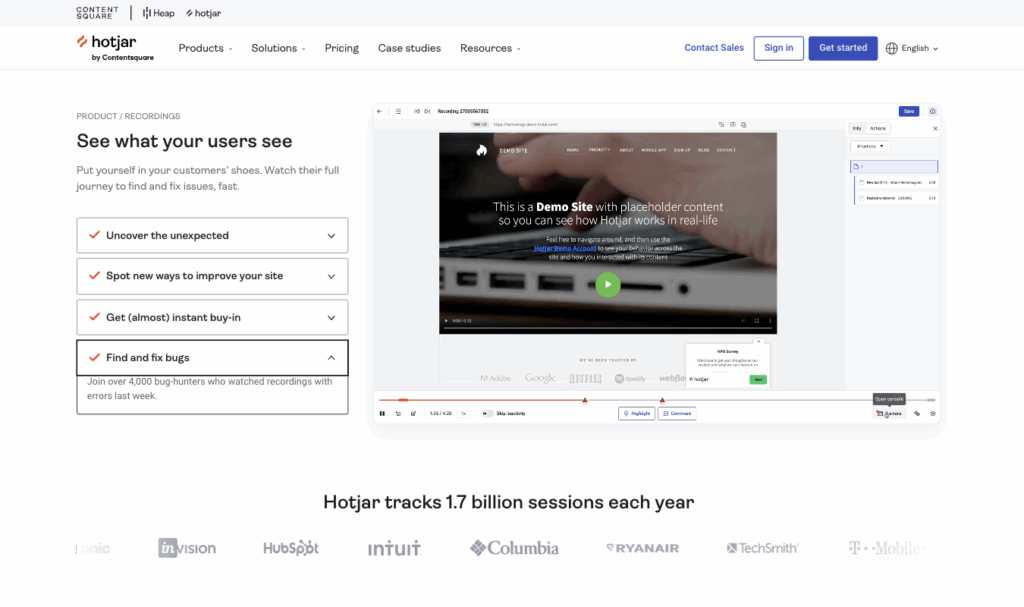
That said, Hotjar doesn’t offer any AI summaries for its recordings, which is somewhat surprising. If Microsoft can offer that feature as a free tool, it seems like Hotjar, as a paid tool, could offer it.
Especially since Hotjar does have an AI feature for its survey tools.
Users must find other ways to summarize session recordings—either manually or through a third-party tool.
Surveys and Feedback
Microsoft Clarity
Unfortunately, Microsoft Clarity offers zero survey or feedback tools. This gives Hotjar—which has both—a massive edge in the user feedback department.
Hotjar
Hotjar offers all the survey and feedback features you could ever want. The website analytics tool is clearly built to capture the “why” behind user behavior, not just the “what.”
This is where it has something Microsoft Clarity doesn’t.
I consider this feedback toolkit one of Hotjar’s strongest selling points. User get:
- On-page feedback widgets. These are small, persistent widgets web visitors can click to rate a page or share comments in real time. They’re great for capturing impressions while the experience is fresh.
- Targeted surveys. Customizable surveys that appear only under specific conditions—like after someone makes a purchase, on a user’s exit intent, or when returning visitors arrive on the site. You can choose from multiple question types (rating scales, open text, multiple choice) to get both quantitative and qualitative feedback.
- AI-powered survey insights. Here’s where Hotjar’s AI shines. It automatically analyzes survey responses. Then, it organizes related feedback into groups, finds trends in user sentiments, and gives you a summary of the survey results. This greatly reduces the manual work of reading and sorting every single response.
- Multi-language support. Surveys and widgets can be translated to match your users’ language. This is essential for brands with a global reach.
- Behavioral targeting. Hotjar can trigger surveys and feedback requests based on user behavior. For instance, after they scroll a specific percentage of a page, visit a pricing page more than once, or click on a certain button.
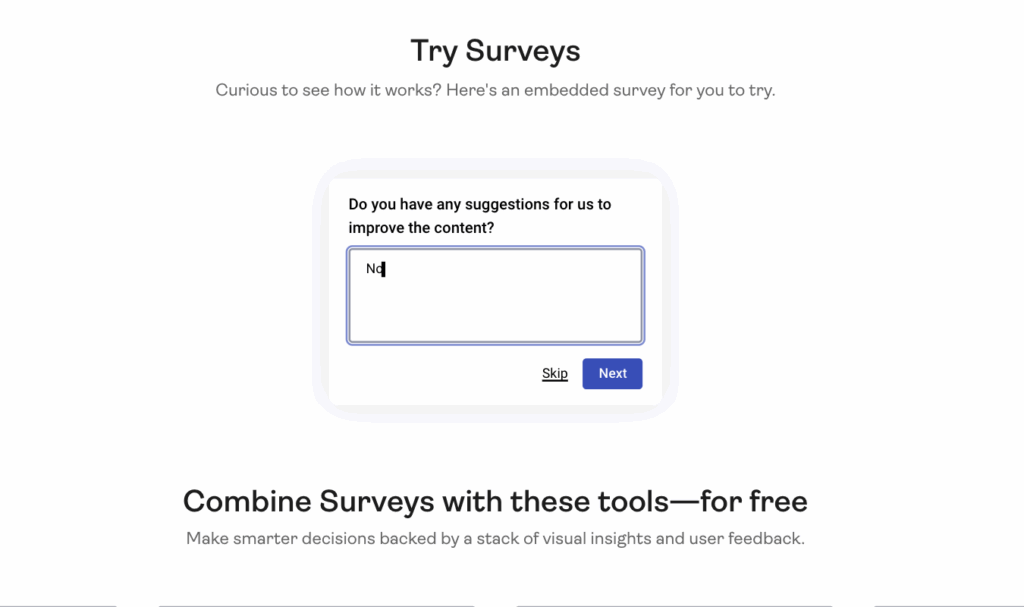
Together, these feedback-gathering features blow Clarity out of the water.
Integrations
Microsoft Clarity
Microsoft Clarity has a pretty decent suite of integrations for what it offers. The integrations include everything from Google Analytics and AB Tasty to Hubspot and Optimizely. Basically, it’s got integrations for metrics and A/B tests.
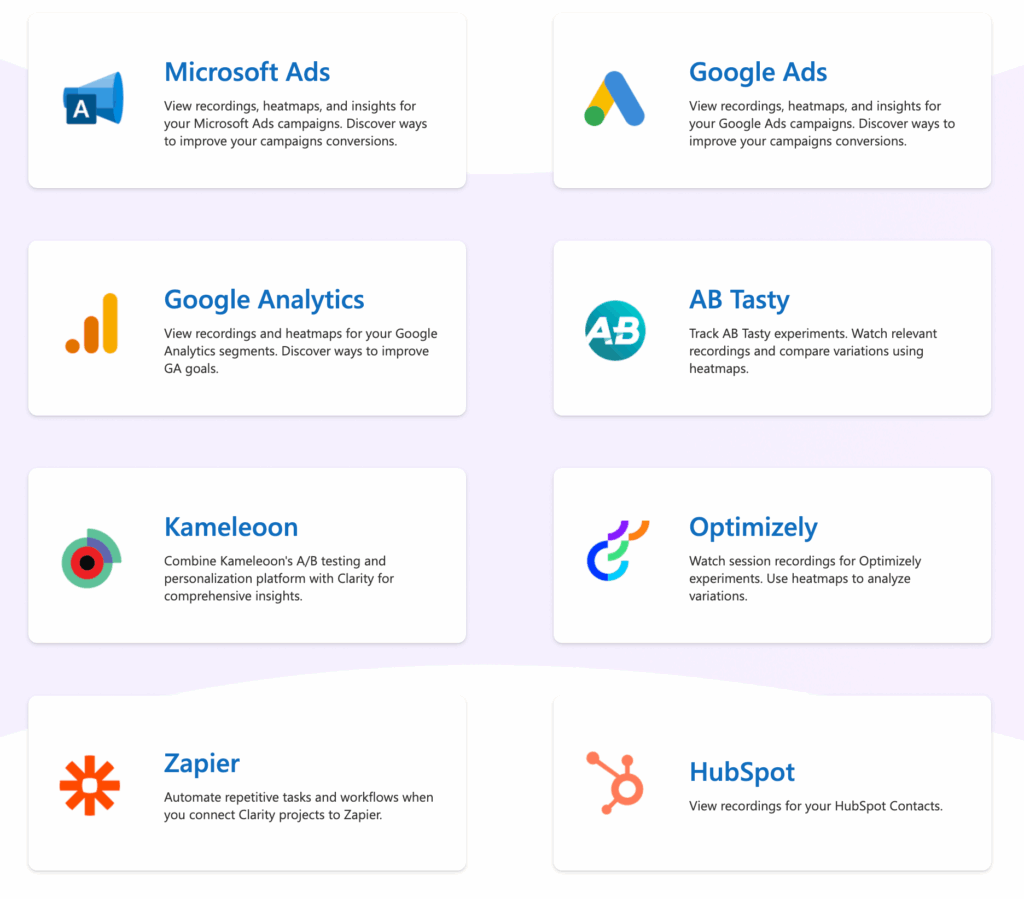
What it doesn’t have are any integrations for collaborating with your team.
Hotjar
Hotjar has a wider set of integrations. You’ll get Slack, Microsoft Teams, Jira, Trello, and Asana to help you stay connected with the rest of your team.
For A/B testing and metrics, Hotjar offers integrations with AB Tasty, Optimizely, and Unbounce. Survey and feedback integrations for Hotjar include Kissmetrics, Contentsquare, Freshpaint, RudderStack, and Amplitude.
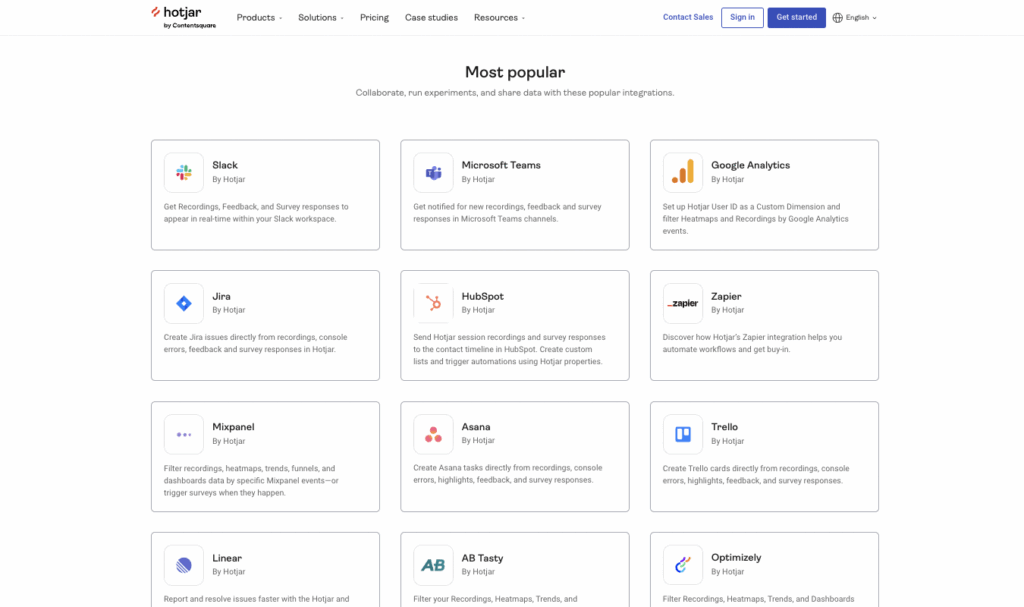
You get the idea.
Funnel Tracking
Microsoft Clarity
Once upon a time, Clarity lacked funnels to help web owners visualize the journeys customers take as they navigate the site. But in 2024, Clarity added a full-fledged funnels feature.
Users can now build funnels, code-free, from page visits or smart events. You can see a visual chart on your dashboard and hop straight into the recordings or heatmaps at any step of a funnel.
Funnel features include:
- Drag-and-drop editing. Easily create and edit, reorder, or rename steps any funnel. Save each funnel from right within your Clarity dashboard.
- Metrics. See conversion rate, sessions converted, and median time to convert in the area above the funnel.
- Analysis at the step level. See exactly how many sessions reached each step of the funnel and then see the filtered heatmaps and/or recordings for that exact point.
- Advanced funnel segmenting. Turn any funnel step into a filter so you can focus on a specific group of users—like those who reached checkout but didn’t buy—and see only their recordings, heatmaps, and other reports.
These funnel tracking features make Microsoft Clarity a true competitor for paid tools like Hotjar.
Hotjar
Despite Clarity’s best efforts, Hotjar still leads on customization around funnels and dashboards. For example, you can create funnels with multiple steps—like “view page” to “click element” to “trigger event”—and then compare how your audience segments perform at each step.
Even better, you can save these funnels onto custom dashboards where they appear alongside trend charts, feedback data, and KPIs for a full picture of that site’s performance.
Hotjar offers:
- Easy funnel editing. You can add, remove, reorder, or rename funnel steps whenever you want.
- Customizable funnel depth. Build funnels with up to 10 steps and easily navigate into the linked recordings and heatmaps to see where any drop-offs happen.
- Unlimited dashboards. Create as many dashboards as you want with Hotjar’s dashboard templates for everything from bug tracking to campaign monitoring. You can even pin relevant funnels, charts, and widgets into each dashboard.
These advanced funnel tracking features allow for quick, ongoing testing and optimization.
Privacy and Data Use
Microsoft Clarity
What it doesn’t cost you in cash, Microsoft Clarity costs you in privacy.
Okay, that’s a little dramatic.
Here’s the deal. Microsoft Clarity is GDPR-compliant in the way it controls data. It also processes data in line with the California Consumer Privacy Act (CCPA).
That said, Clarity does not honor a browser’s Do Not Track (DNT) header. This means that even if users have enabled Do Not Track in their browser, it won’t stop Clarity from recording sessions.
In the EU, UK, and Switzerland, Clarity requires explicit consent from the user before tracking starts. Without this consent, features like session replays, funnels, and user journey analysis won’t activate.
Clarity stores all its data on Microsoft Azure with enterprise-grade encryption. And if you want Clarity to mask sensitive content, like form inputs or email fields, you can do so, but it takes some digging around in settings to find the controls to do this.
While Microsoft Clarity doesn’t sell data to third parties, it may use aggregated and anonymized data for industry benchmarking and analytics. In fact, this is the very reason why Clarity is free. It’s essentially offered in exchange for these analytics.
Finally, you can’t delete a single user’s data from a project file if they request you do so. Instead, you have to delete the entire project. This is hugely inconvenient.
Hotjar
Hotjar is more privacy-oriented than Clarity. It’s fully GDPR and CCPA compliant, it respects Do Not Track settings on user’s browsers, and it offers consent management and data masking tools.
You can delete an individual user’s data when they request it without deleting your whole project.
Hotjar abstains from profiling data for any reason—even aggregated and anonymized data— and it does not sell data to third parties.
Like Microsoft Clarity, Hotjar uses enterprise-grade encryption to protect data at all times.
Pricing Breakdown: Which Has the Best Value?
Microsoft Clarity is obviously the least expensive. But this doesn’t necessarily mean it offers the best value. Hotjar has a free plan, too, and it offers features—like surveys—that Clarity doesn’t.
Here’s an overview of how the prices stack up against each other.
| Plan Tier | Microsoft Clarity | Hotjar (Observe Plan Only) |
| Entry-level | $0 – Free forever Unlimited heatmaps. Unlimited session recordings. No traffic limits, no paid upgrades required. | Basic – $0 (Free) Up to 35 daily sessions. Unlimited heatmaps. Basic filters, dashboards, highlights features, surveys, and feedback. |
| Mid-range | Not applicable (Clarity has no paid tiers) | Plus – $39/month (or ~$32/month billed annually) Up to 100 daily sessions. Advanced filters (page, device, country, duration, events). |
| High-end | Not applicable | Business – $79/month (annual) or ~$99/month (monthly) Up to 500–270,000 daily sessions. Includes funnels, trends, engagement and frustration scores. |
| Trial Period | Not needed (free forever) | No trial needed. Free plan is ongoing. Paid plans come with a 30-day money-back guarantee. |
It’s worth noting that Hotjar frames its pricing a little bit strangely. It splits its offerings into three categories:
- Observe. Includes recordings and heatmaps.
- Ask. Includes surveys and feedback.
- Engage. Includes one-on-one user interview and feedback tools.
On the Hotjar pricing page, you’re encouraged to pick an Observe plan—which only applies to a single website. Hotjar states that with any Observe plan, you’ll get basic versions of Ask and Engage (aka the already free stuff) for free.
The free versions are fairly limited—you only get three surveys in the free Ask plan, for instance.
To get unlimited surveys, you’ll have to buy a Plus plan ($48 a month, billed annually) for the Ask set of products. Want more than three interviews for the Engage product tier? You’ll need to shell out another monthly chunk of cash.
It adds up quickly.
Honestly, if you don’t need surveys and you don’t mind Microsoft Clarity using aggregated, anonymized data from your sessions for its own marketing purposes, Microsoft Clarity offers the greater value.
Plus, that AI summary feature Clarity has is significant, in my opinion. Who wants to transcribe their own heatmaps and recordings? No one, that’s who.
With Clarity, you get that feature for free. Along with every other feature Clarity offers.
Final Verdict: Is Microsoft Clarity or Hotjar Right for You?
If you’re an enterprise brand with complex heatmapping, dashboarding, funneling, and surveying needs—and you have the budget to pay for Hotjar—it’s a great tool to use.
Just remember: if you have more than one website, you’ll need to buy separate Observe, Ask, and Engage plans for each one.
But if you just want a core set of heatmapping, recording, and funnel-tracking tools, Microsoft Clarity is a no-brainer.
Especially because it costs you zero dollars, is always updating its features, and honestly is just downright impressive at what it does.




